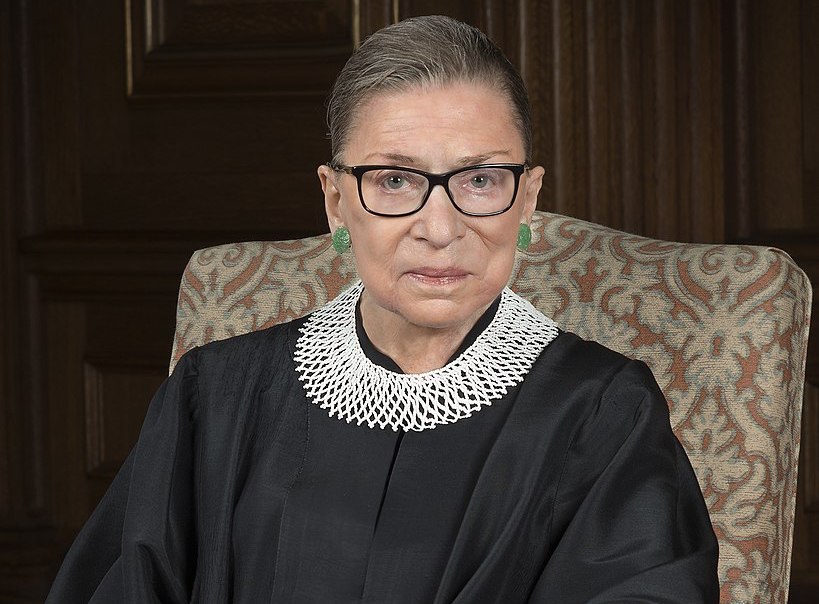Ruth Bader Ginsberg faced difficulties getting a good job and equal pay because of her gender and identity as a mother but eventually found a way to not only transcend the limits placed upon her but free others from theirs as well. This is the story of the life of the tiny legend they call RBG.
1933 – Joan Ruth Bader Ginsberg is born to immigrant parents from the Ukraine and Poland. She has an older sister who is 4 years older. Her father sells fur hats and coats, her mother is a homemaker. They live in a two-family house in Brooklyn, New York.
Age 2 – Joan’s elder sister dies at age 6. Her mother teaches her to read.
Childhood – Joan begins to go by her middle name, Ruth because there are too many Joans in her class. She is a good student who likes to play jump rope and skates. Her mother often takes her to the theatre and library.
High school – She remains physically short. She gets straight As and plays the cello at the high school orchestra. And she joins the Go-Getters Pep Club, edits the school newspaper and dates boys. There are no sports teams for girls in her school. In the meantime her mum is diagnosed with cancer and undergoes treatment. Ruth does her homework by her mother’s bedside at night.
Age 17 – Her mother dies one day before her graduation. She misses graduation because of this.
College – Ruth goes to Cornell University using funds her mother saved up for her. She decides to pursue a career in law in university. She meets Marty Ginsburg who she says is the only boy she met who cares that she had a brain. They both apply to Harvard and get in.
Age 21 – She graduates from university and marries Marty a few days later. Shortly after, he is called to serve 2 years on an army base in Oklahoma and she moves there with him, taking a job at a Social Security office.
Age 22 – They have a baby daughter and name her Jane.
Age 23 – They leave the military base and go to Harvard law school together. Of the 500 students in class, Ruth is just one of 9 women.
Age 24 – While juggling child-care and studying, they discover Marty has cancer and has to begin treatment immediately. Ruth takes on looking after him as well.
Age 25 – Marty beats cancer and graduates on time. He gets a job in New York City. To be with him, Ruth moves to New York City and completes her last year of law school at Columbia University.
Age 26 – Ruth graduates as number one in her class. However despite sending in over 40 job applications, not one law firm wants to hire her because she is female and a mother. She ends up working as a clerk to a federal judge.
Age 30 – She gets a new job as a law professor at Rutgers University in New Jersey. She becomes one of the few female law professors in the country but is paid less than her male colleagues doing the same job.
Age 32 – Her son, James is born. She transfers to Columbia University Law School and eventually becomes the first woman to receive tenure there.
Age 39 – She files a lawsuit for equal pay for female professors at her university and they win. Then she volunteers as a lawyer for the American Civil Liberties Union.
Age 40 – She fights to get Air Force housing and medical care benefits for the husband of her client, Sharron Frontiero who was denied such benefits on the basis of being female. She wins and this impacts all women working in the US military from then on.
Age 42 – She fights for the right for a single father Wiesenfeld to get benefits for staying home to look after his baby son—a right which is usually only paid to women. She wins again. For the next few years, she will go on to pursue more historically significant cases and win most of them.

Age 50 – Ruth is appointed federal judge in Washington D.C.. She has to quit teaching and representing cases as a lawyer as a result. Marty moves along with her and gets himself a new job teaching law in Washington.
Age 60 – President Clinton picks Ruth to be the next justice at the US Supreme Court, and also its second woman ever. The Senate unanimously votes her in. She becomes one of the nine justices in the Supreme Court.
Age 63 – She continues to fight for gender equality in Court and is considered part of the Court’s liberal wing.

Age 66 – She is diagnosed with colon cancer. She continues to work while receiving treatment.
Age 76 – She is diagnosed with early-stage pancreatic cancer but goes back to work after her operation.
Age 77 – Marty dies of cancer.
Age 80 – The majority of the justices in the Supreme Court vote to remove parts of the Voting Rights Act. Ruth vehemently disagrees with this. Citizens who agree with her begin seeing her as a hero. She goes viral on the internet and people start calling her RBG. She becomes famous despite not being able to change the ruling.

Age 85 – A documentary about her life, ‘RBG’ is shown nationwide. A film about her called ‘On the Basis of Sex’ follows.
Age 87 – She dies at home from pancreatic cancer.
More life summaries available here.
Photographs: Supreme Court of the United States. Compiler: Sy
Sponsor or support the Life Summary series here.
If you found this article useful:


Say something: